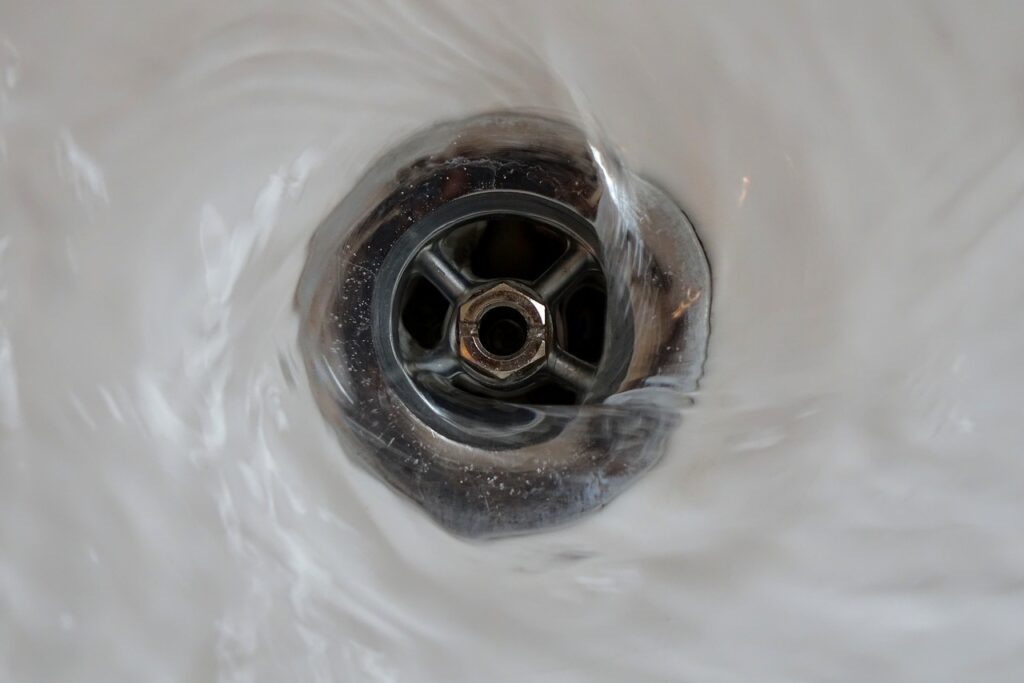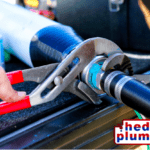There will come the point where you need to find out the cause of a plugged-up and clogged drain. While many plugged drains are easy to solve, they sometimes require a professional touch. Before you go ahead and call a plumber, though, you will benefit from learning what you can do about a plugged drain to protect your home and maintain a happy, healthy, and stress-free environment.
Where Do Plugged Drains Occur
A plugged drain can occur anywhere there is a faucet or water source. The water needs somewhere to go, whether down the sink or through the shower and bath drain. Besides this, your drain pipes running around the exterior of your house (below the roof) also pose a risk of clogged drains. The same goes for the pipe that takes wastewater away from your home and links up with other drainage systems throughout the neighborhood.
These areas can experience a plugged drain, but the reasons why drains become plugged will vary depending on what goes down them.
Why Does It Happen?
Most of the time, water is the primary thing that goes down a drain. This happens when you shower, wash your hands or do the dishes. However, water is not the only thing that can end up down the drain.
Hair
Hair is perhaps the most common thing that contributes to a clogged drain. Most people in your household have hair, and while you won’t lose huge clumps at a time, enough hair can come out while washing it to clog the drain.
This won’t happen overnight, but the hair can build up over time. You will be able to spot hair tangled in the shower drain, and there might be even more further down the pipe. The more people with long hair in your household, the bigger the likelihood that hair is clogging your drains. If the water does not drain as quickly, and you find yourself standing in a small puddle, it’s time to clear out any hair.
Pieces of Food
It’s good practice to wipe your plate entirely clean after a meal and put food scraps in the garbage disposal or the bin. However, not everybody does this, and these food bits can plug up your drain quickly if you are not careful.
This is especially true for larger food pieces that do not disintegrate the same way a piece of bread might. Pieces of meat are a common culprit. Still, even small crumbs, seeds, and even coffee grounds can plug your drains.
You can easily tell when a drain is clogged because the sink does not empty as quickly. With food pieces, there might also be an unpleasant odor emanating from the drain where trapped food has started to rot.
Grease
You shouldn’t just think about food pieces plugging your drains. Grease and oils from cooking can also cause severe drainage issues. However, not everyone thinks about this, and they believe that pouring cooking grease down the drain after a meal is not a problem.
The reality is quite different, though. Although the grease might be liquid when poured down the drain, it can solidify in the drain, especially if you do not flush it away properly. Over time, the grease will build up and cause a significant blockage, which will damage your pipes and could cause them to burst.
Putting the Wrong Things Down the Drain
Some people consider the toilet as a magical device that gets rid of everything without consequence. However, this is far from true. The only things that should go down the toilet are human waste and toilet paper, as these will disintegrate before joining the sewage system.
Things like baby wipes and cotton buds are two common items that drain experts find when clearing a clogged drain. It has become such a problem that many brands will label their products with Do Not Flush to protect your drains and pipes.
Bath Salts and Bombs
If you love to take a relaxing soak in the tub, you might want to enhance this with some relaxing bath salts or even a fun, colorful bath bomb. While you’re totally within your right to enjoy this, especially if you want to recover from sore muscles or unwind after a stressful day, you should also know that these luxuries can pose a problem.
Although they are designed for baths and should dissolve before draining, cheap products might not boast this quality. The salts might clump together, or the bath bomb could have non-dissolvable ingredients. It doesn’t take an expert to understand why this could affect your drains.
Kids Toys
Kids’ toys ending up down the drain is unlikely, but not impossible. If your kids love to play with toys in the bath or have a curious fascination with where the water goes, they might test any theories by flushing or dropping their toys down the drain. As toys are not designed to be flushed, they will easily become clogged in pipes, blocking things that are okay going down the drain and potentially backing up your pipes, causing an overflow.
Too Much Toilet Paper
Likewise, flushing too much toilet paper (another thing that some kids will do) can block the drains. While toilet paper is supposed to disintegrate in water, too much of it clumped together can make this difficult. This means that it may get to a point in your drain where it has not dissolved enough, causing a significant blockage.
Along similar lines, paper towels are another thing you shouldn’t flush down the toilet. While they might not seem any different, the thicker paper makes it more difficult for them to dissolve, so do not use them as an alternative to toilet paper, and put them in the garbage rather than down the toilet if you use them to clean the sink, shower, and other parts of the bathroom.
Soap
You wouldn’t expect soap to be a significant cause of plugged drains. However, like bath salts, larger pieces of soap can clump together and block the passageway. This usually happens when you get to the end of a bar of soap. As it falls apart in your hands, bigger pieces might end up down the drain. To avoid this, stick the last sliver of soap to a new bar instead of using it until; the very end.
Leaves and Tree Debris
Another drain issue you should consider is your outside drains and guttering. You won’t find toys or clumps of bath salts here, but you might find leaves and tree debris, especially following a storm or during the winter.
This debris can cause an unfortunate blockage that makes your gutters too heavy, causing them to snap off the side of the home. Rainwater can also flush them down the drainpipe, while sub-zero temperatures will cause them to freeze and block water from draining properly.
What Can You Do About Plugged Drains?
Plugged drains are likely to cause immediate panic, and you should get them fixed as soon as possible. Luckily, there are a few remedies that you can try yourself to solve any plugged drain issues and protect your home.
Use a Plunger
Every home should have a plunger, and everyone will tell you to buy a plunger before you need a plunger. This is a simple but effective solution for a myriad of clogged drain issues, and it is so easy to use that anyone can do it.
There are two types of plunger you will need to guarantee peace of mind within your home. This is the standard plunger that you use for sinks as well as a toilet plunger, which is shaped slightly differently and allows you to access the toilet shape with ease.
After encountering a plugged drain, a plunger should be the first thing you try, using the pressure to loosen any debris that clogs the passageway.
Inspect Your Garbage Disposal
If your home has a garbage disposal, there is a strong possibility that pieces of food have caused a clog. If your sink is not draining as efficiently as you are used to, you can check your garbage disposal to see if any pieces of food are blocking the water.
As garbage disposals are designed to shred pieces of food, you should be careful to turn it off before checking. You might find that the disposal is not operating as efficiently as it used to, so you may need to repair or replace it. It is possible to do this yourself, but if you have any uncertainties, a professional might be the best bet.
Use a Plughole Screen
If you do not have a garbage disposal, the risk of food bits going down the drain increases dramatically. While it might not seem like much on a day-to-day scale, food bits will eventually cause a substantial plug that could damage your drain and pipes. If you live in a shared property or apartment building, you put other tenants at risk, too.
A plughole screen is a simple yet effective solution that stops food from going down the sink. You can find screens that are designed specifically for your plughole, but you can also find standard models that should fit any standard plug.
It won’t stop all food bits, but it will reduce how much food goes down the sink, especially larger pieces of meat or vegetables, which will reduce the risk of any blockages.
Buy a Drain Snake
Drain snakes are similar to plungers in that they can remove blockages, despite using slightly different methods. While plungers use air pressure to loosen food or other debris, a drain snake can push through the blockage to loosen the debris and clear any standing water.
There is more to it than this, however. As you remove the drain snake, its design will catch hair and pull it out of the drain altogether, clearing the way for water and stopping the debris from being flushed further down.
This is beneficial as it stops the clog from happening again further down the pipeline where it could be more challenging to access, which might make the repair and maintenance more expensive. Ideally, you should have a plunger and a drain snake in your home to deal with any issue.
Use Household Items
You don’t need to rely on supermarket miracle products to clear your drain. If you’re tackling smaller plug problems, a few everyday household items can come to the rescue.
Everything from boiling water to baking soda and vinegar can be effective against certain blockages in your sink or bathtub. While it might not sound quite right to add more water to a blockage, the high temperatures can help dissolve some debris after removing the standing water.
If this does not work, baking soda and vinegar can provide similar results. You’ll still need boiling water and dish soap, while a cup each of baking soda and vinegar will work their magic. You can fix any issues in around 15 minutes, repeating where necessary, or leave them overnight.
Clean the P-Trap
Most sinks will have a P-Trap directly underneath. This is a curve in the pipe where food and other debris could get caught, causing an unfortunate blockage. You don’t need to be an expert to clean this, but you should still find a bucket or container to place underneath the curve to catch anything that falls out.
Unfasten the pipe and clear out the pipe. You may also need to pull stuck-on debris from inside the pipe. When you are finished, fasten the pipe in place and run water through to make sure there are no leaks.
Call in the professionals
While there are some plugged drain problems that you can solve all by yourself, there are other issues that are too complex or even too dangerous for you to attempt. This is usually anything involving the main sewage drain, or when a plumber’s expertise is required to deal with significant problems and potential damage. Anyone who needs to solve their plugged drain problems with confidence should get in touch with Hedlund Plumbing today to find out the type of services we offer and how we can ensure your drains are cleared to guarantee a healthy and happy household.
With a combination of consistent drain care and maintenance, home remedies, and professional advice and assistance, you won’t need to deal with plugged drains ever again.




